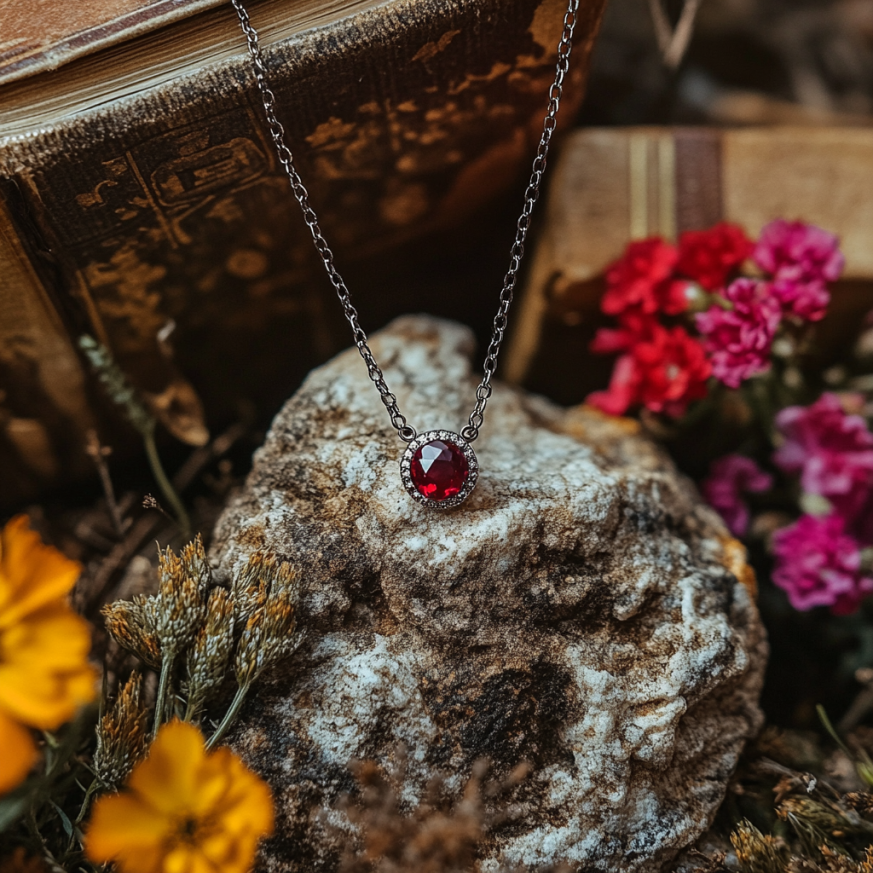Evaluating Ruby Quality Factors
Rubies are among the most valuable and sought-after gemstones, prized for their rich red color, durability, and rarity. Evaluating Ruby Quality Factors involves assessing several key aspects, including color, clarity, cut, and carat weight—often referred to as the 4Cs. Additionally, Evaluating Ruby Quality Factors also means considering the gemstone’s origin, any treatments it has undergone, and its overall brilliance, all of which contribute to a ruby’s desirability and market value.

1. The 4Cs of Ruby Quality
A. Color – The Most Important Factor
Ruby’s value is largely determined by its hue, tone, and saturation. The most desirable rubies exhibit a pure red or slightly bluish-red hue, often referred to as pigeon blood red.
- Hue: The primary color of rubies is red, but they may have secondary undertones of pink, purple, orange, or brown.
- Tone: Ideal rubies have a medium to medium-dark tone—not too light (pink sapphire) or too dark (blackened appearance).
- Saturation: High-quality rubies display vivid, rich red saturation without dullness or grayish tones.
| Ruby Color Grade | Description | Value |
| Pigeon Blood Red | Pure red with a slightly bluish hue, vibrant and intense | Highest |
| Vivid Red | Bright and well-saturated red | High |
| Pinkish-Red | Lighter in tone, may be classified as pink sapphire | Moderate |
| Purplish-Red | Deep red with purple undertones | Moderate |
| Brownish/Orangey-Red | Muted red with secondary brown/orange hues | Lower |
B. Clarity – Evaluating Inclusions
Rubies naturally contain inclusions, but the best stones have minimal visible imperfections.
- Eye-Clean Rubies (no visible inclusions) are extremely rare and valuable.
- Common Inclusions: Silk (fine rutile needles), fingerprints, and color zoning.
- Star Rubies: Certain inclusions can create an asterism effect, enhancing desirability.
Clarity Grading:
| Clarity Grade | Description | Value |
| VVS (Very Very Slightly Included) | No visible inclusions under 10x magnification | Highest |
| VS (Very Slightly Included) | Inclusions barely visible under magnification | High |
| SI (Slightly Included) | Small inclusions visible under magnification, may affect brilliance | Moderate |
| I (Included) | Inclusions visible to the naked eye, may reduce durability | Lower |
C. Cut – Balancing Brilliance and Weight Retention
Unlike diamonds, rubies are cut to maximize color and carat weight rather than brilliance.
Best Ruby Cut Styles:
- Oval and Cushion Cuts: Most common, retaining maximum carat weight while enhancing color.
- Round Cut: Offers brilliance but results in more weight loss, making large round rubies rare.
- Emerald Cut: Ideal for high-clarity rubies, but reveals inclusions more easily.
- Cabochon Cut: Used for star rubies and heavily included stones.
A well-cut ruby should:
✔ Display even color distribution.
✔ Avoid windowing (see-through areas).
✔ Have well-balanced proportions without excessive depth or flatness.
D. Carat Weight – Size and Value
Larger rubies are significantly rarer than diamonds, making carat weight an important factor in pricing.
| Carat Weight | Typical Availability | Price Impact |
| Under 1 Carat | Common, widely available | Lower |
| 1-3 Carats | High-quality rubies in this range are rare | High |
| 3-5 Carats | Very rare in fine quality | Premium |
| Over 5 Carats | Extremely rare and valuable | Exceptional |
A high-quality 3-carat ruby can be significantly more expensive than a lower-quality 5-carat stone.
2. Additional Ruby Quality Factors
A. Origin – Where the Best Rubies Come From
Ruby origin plays a major role in determining quality and market value.
| Origin | Quality Characteristics | Market Value |
| Myanmar (Burma) | Pigeon blood red, excellent saturation | Highest |
| Mozambique | Vibrant red, high clarity | High |
| Thailand | Darker, purplish-red | Moderate |
| Sri Lanka | Light pinkish-red, high clarity | Moderate |
| Vietnam | Intense red with slight purple tones | High |
| Tanzania & Madagascar | Varies widely, some fine gems found | Moderate |
Burmese rubies are the most sought-after, with Mozambique rubies gaining recognition for their fine color and clarity.
B. Treatment – Enhancements That Affect Value
Most rubies undergo some form of treatment to improve color and clarity.
| Treatment Type | Effect on Ruby | Value Impact |
| Heat Treatment | Enhances color naturally, widely accepted | High |
| Fracture Filling (Lead-Glass Filled) | Fills cracks to improve clarity, makes ruby fragile | Lower |
| Diffusion Treatment | Adds artificial color, not highly valued | Low |
| Untreated (No Enhancement) | Completely natural, rarest and most valuable | Highest |
Always ask for a gemological certification (GIA, GRS, or AGL) when purchasing high-value rubies.
C. Brilliance and Light Reflection
A ruby’s internal glow and how it interacts with light contribute to its visual appeal.
- A high-quality ruby glows from within, appearing lively rather than dull.
- Poorly cut rubies may exhibit windowing (excessive transparency) or extinction (dark areas), reducing visual impact.
3. How to Choose a High-Quality Ruby
When selecting a ruby, consider:
✔ Color First – Choose a vibrant red hue with high saturation.
✔ Check Clarity – Avoid excessive inclusions that affect durability.
✔ Prioritize Cut – Ensure the ruby has an even color distribution and no windowing.
✔ Balance Carat Weight & Quality – A smaller high-quality ruby is more valuable than a larger lower-quality one.
✔ Verify Origin & Treatment – Ask for certification to confirm authenticity.
4. Conclusion
Evaluating ruby quality factors involves a careful balance of color, clarity, cut, and carat weight, alongside considerations like origin, treatments, and brilliance. The most valuable rubies exhibit pure red hues, minimal inclusions, and high saturation, making pigeon blood red Burmese rubies the ultimate standard. Whether purchasing for investment or personal use, understanding these factors ensures you select a ruby of exceptional beauty and value.
